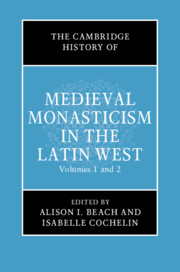Book contents
- The Cambridge History of Medieval Monasticism in the Latin WEST
- The New Cambridge History of Medieval Monasticism in the Latin West
- The Cambridge History of Medieval Monasticism in the Latin WEST
- Copyright page
- Contents
- Figures
- Contributors
- Acknowledgments
- Abbreviations
- 1 General Introduction
- Part I The Origins of Christian Monasticism to the Eighth Century
- 2 The Monastic Laboratory: Perspectives of Research in Late Antique and Early Medieval Monasticism
- 3 Re-Reading Monastic Traditions: Monks and Nuns, East and West, from the Origins to c. 750
- 4 The Archaeology of the Earliest Monasteries
- 5 Egyptian Nuns in Late Antiquity as Exemplars
- 6 Psalmody and Prayer in Early Monasticism
- 7 Heterodoxy and Monasticism around the Mediterranean Sea
- 8 The Invention of Western Monastic Literature: Texts and Communities
- 9 Monastic Rules (Fourth to Ninth Century)
- 10 Social Plurality and Monastic Diversity in Late Antique Hispania (Sixth to Eighth Century)
- 11 Female House Ascetics from the Fourth to the Twelfth Century
- 12 The Archaeology of the Earliest Monasteries in Italy and France (Second Half of the Fourth Century to the Eighth Century)
- 13 Nuns and Monks at Work: Equality or Distinction between the Sexes? A Study of Frankish Monasteries from the Sixth to the Tenth Century
- 14 Ascetic Prayer for the Dead in the Early Medieval West
- 15 Monastic Identity in Early Medieval Ireland
- 16 Constructing Monastic Space in the Early and Central Medieval West (Fifth to Twelfth Century)
- 17 The Economy of Byzantine Monasteries
- Part II The Carolingians to the Eleventh Century
- Part III The Long Twelfth Century
- Part IV Forms of Monasticism in the Late Middle Ages
- Index
- References
17 - The Economy of Byzantine Monasteries
from Part I - The Origins of Christian Monasticism to the Eighth Century
Published online by Cambridge University Press: 16 January 2020
- The Cambridge History of Medieval Monasticism in the Latin WEST
- The New Cambridge History of Medieval Monasticism in the Latin West
- The Cambridge History of Medieval Monasticism in the Latin WEST
- Copyright page
- Contents
- Figures
- Contributors
- Acknowledgments
- Abbreviations
- 1 General Introduction
- Part I The Origins of Christian Monasticism to the Eighth Century
- 2 The Monastic Laboratory: Perspectives of Research in Late Antique and Early Medieval Monasticism
- 3 Re-Reading Monastic Traditions: Monks and Nuns, East and West, from the Origins to c. 750
- 4 The Archaeology of the Earliest Monasteries
- 5 Egyptian Nuns in Late Antiquity as Exemplars
- 6 Psalmody and Prayer in Early Monasticism
- 7 Heterodoxy and Monasticism around the Mediterranean Sea
- 8 The Invention of Western Monastic Literature: Texts and Communities
- 9 Monastic Rules (Fourth to Ninth Century)
- 10 Social Plurality and Monastic Diversity in Late Antique Hispania (Sixth to Eighth Century)
- 11 Female House Ascetics from the Fourth to the Twelfth Century
- 12 The Archaeology of the Earliest Monasteries in Italy and France (Second Half of the Fourth Century to the Eighth Century)
- 13 Nuns and Monks at Work: Equality or Distinction between the Sexes? A Study of Frankish Monasteries from the Sixth to the Tenth Century
- 14 Ascetic Prayer for the Dead in the Early Medieval West
- 15 Monastic Identity in Early Medieval Ireland
- 16 Constructing Monastic Space in the Early and Central Medieval West (Fifth to Twelfth Century)
- 17 The Economy of Byzantine Monasteries
- Part II The Carolingians to the Eleventh Century
- Part III The Long Twelfth Century
- Part IV Forms of Monasticism in the Late Middle Ages
- Index
- References
Summary
The Byzantine Empire was, above all, the pars orientis of the Roman Empire and the cradle of Christianity and monasticism. Nevertheless, some interesting parallels can be drawn between the economic and political history of Eastern and Western monasticism throughout the Middle Ages. This Roman East was radically diminished by Arab expansion, which deprived the empire of its richest provinces from both monastic and economic points of view, and also by Slavic invasions. The empire reconquered the Balkans up to the Danube in the middle of the eleventh century, but in the east it barely managed to extend past Antioch in Syria and Edessa in Upper Mesopotamia, even as it expanded in this same period into the southern Caucasus region and up to areas that were never Roman. This expansion was short-lived, as the east was overwhelmed by the Turks in the second half of the eleventh century, which ended with the arrival of the crusaders. Although the crusaders recovered a portion of Asia Minor, they took what Byzantium held east of the Taurus.
- Type
- Chapter
- Information
- The Cambridge History of Medieval Monasticism in the Latin West , pp. 340 - 362Publisher: Cambridge University PressPrint publication year: 2020



